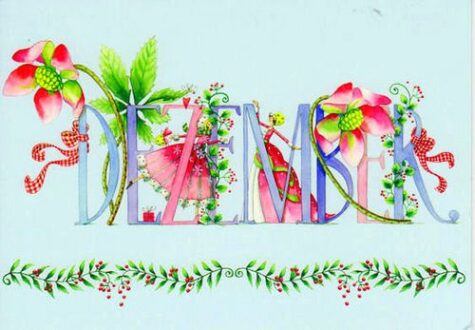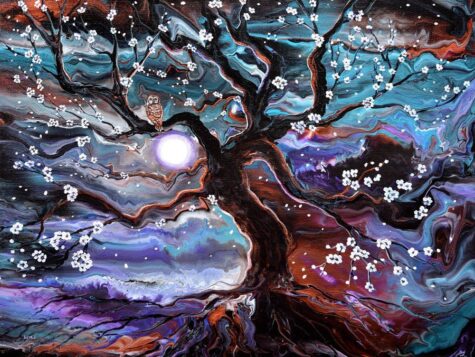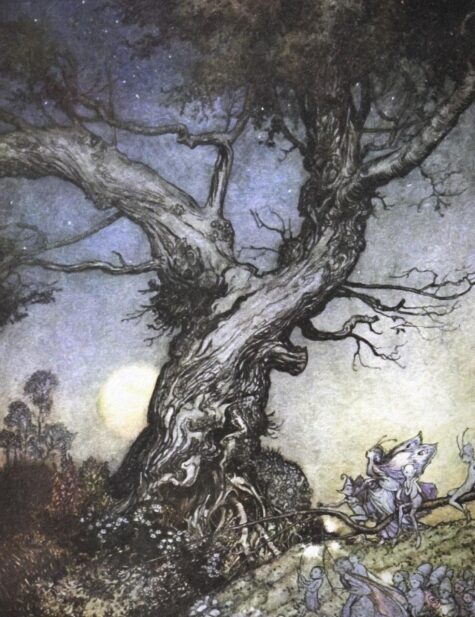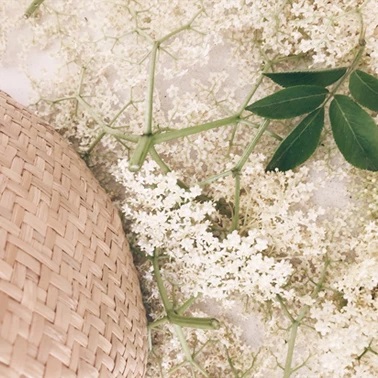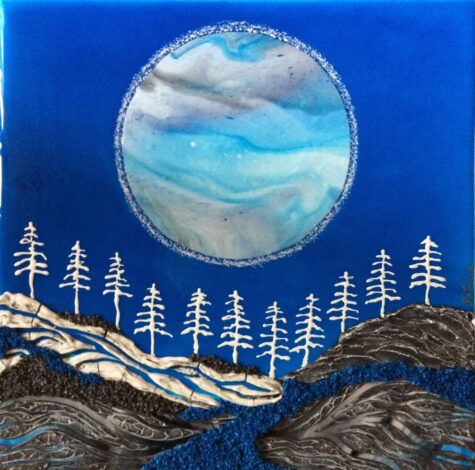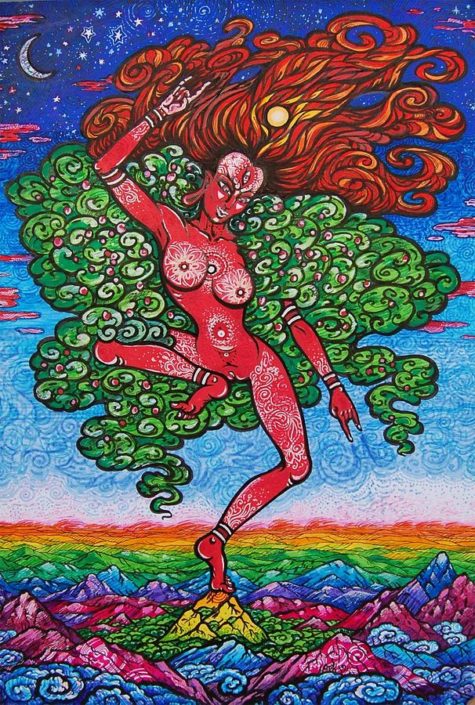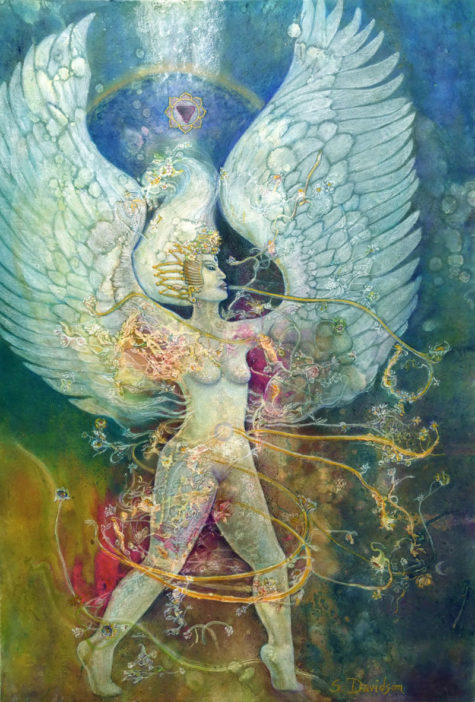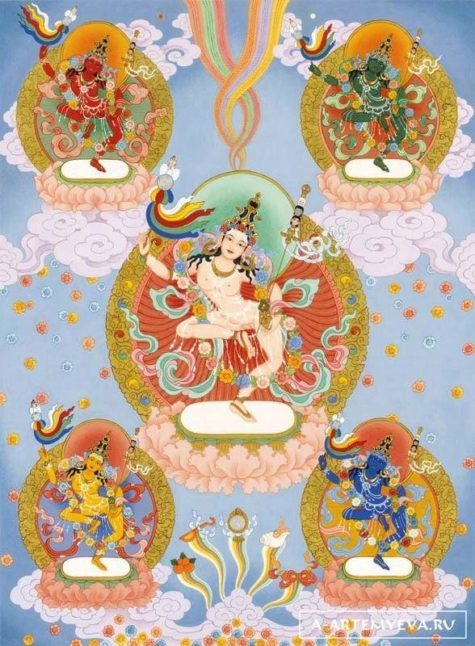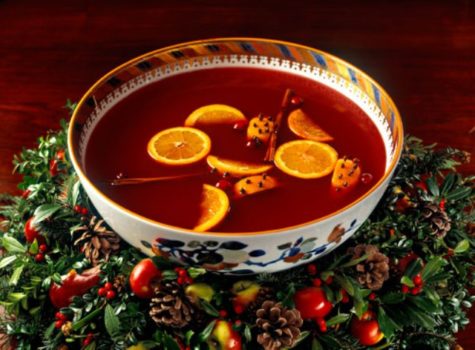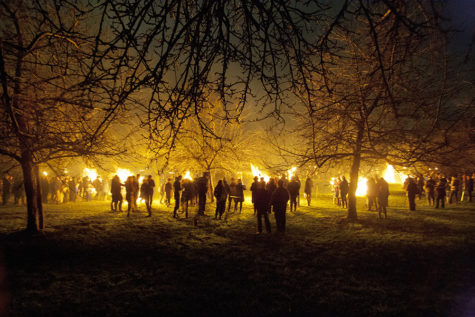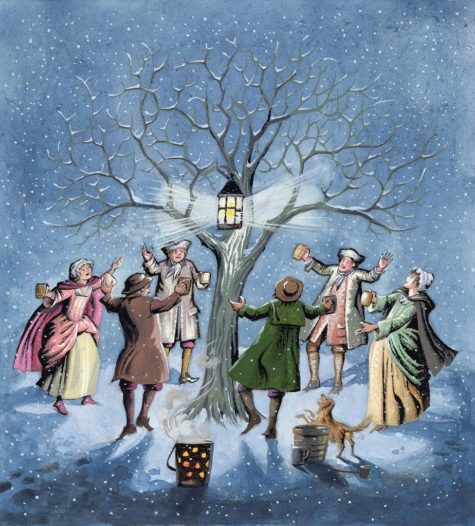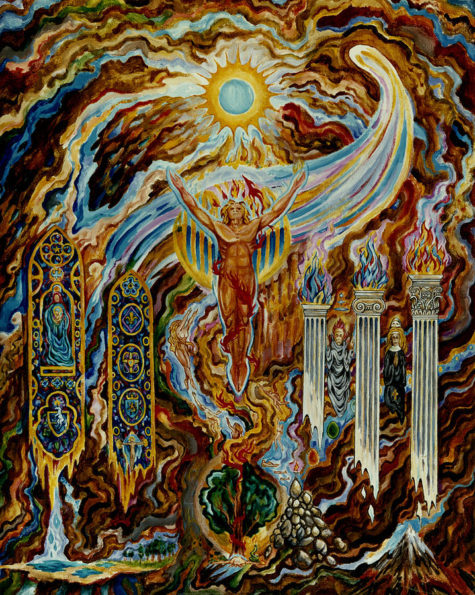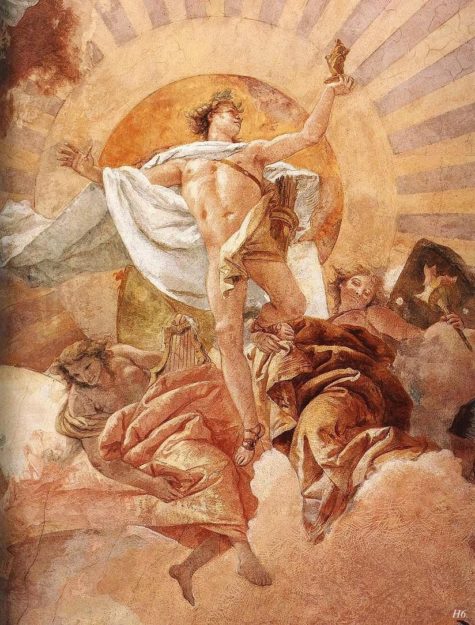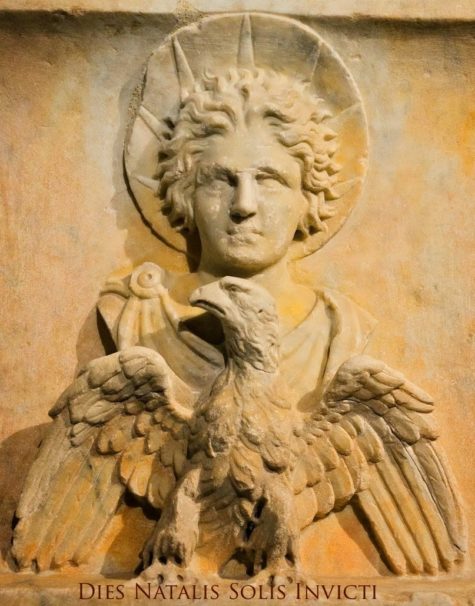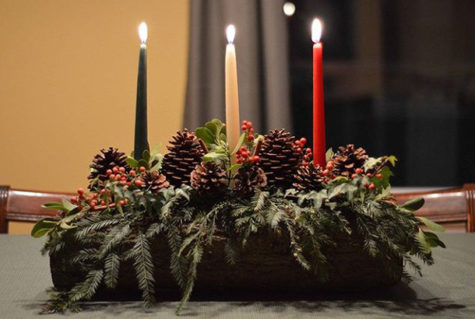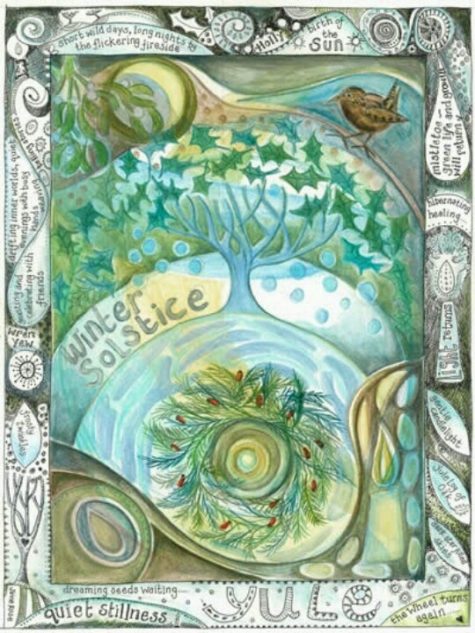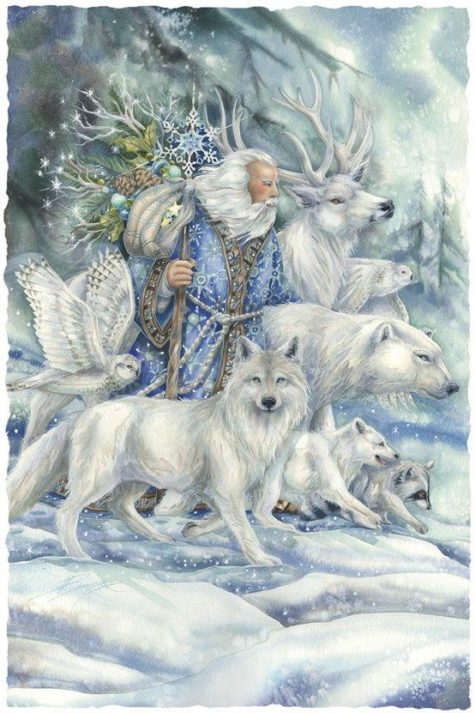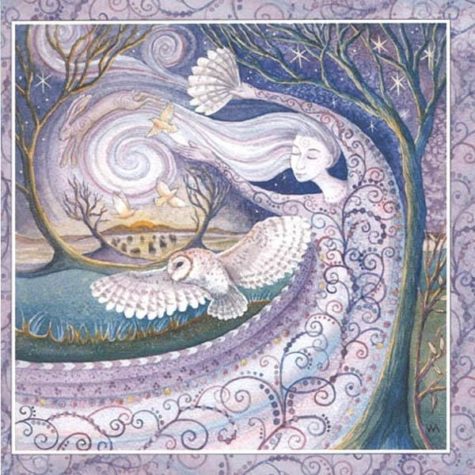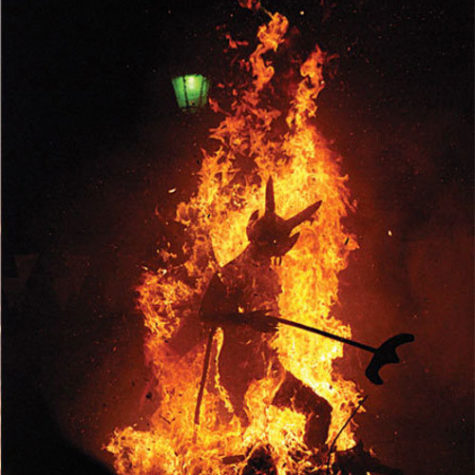December
There is a lot to celebrate in December. This is a list of pretty much everything that goes on during the last month of the year. Many of these dates change from year to year. The days that change are marked with this » symbol.
December Lore and General Info

Astronomical Events
- Sept 7 thru Dec 10: Taurids Meteor Shower
- Dec 4 » Total Solar Eclipse
- Dec 4 » New Moon
- Dec 7 thru Dec 17: Geminids Meteor Shower
- Dec 14: Halcyon Days Begin
- Dec 17 thru Dec 25: Ursids Meteor Shower
- Dec 19 » Full Moon – Big Winter Moon
- Dec 21: Winter Solstice
Astrological Events
Depending on which astrological system you adhere to, these are the signs that show up in December of 2021. Be aware that some of these dates will vary from year to year. Unlike the Sun signs which might just shift by 1 or 2 days, the dates of the various Moon signs will vary widely from year to year. The same holds true for the Chinese Zodiac. The Celtic Tree Signs are based on an arbitrary system and stay the same from year to year.
The December Sun begins in Sagittarius and finishes up in Capricorn:
- Nov 22 thru Dec 21 » Sun in Sagittarius
- Dec 21 thru Jan 20, 2022 » Sun in Capricorn
The moon cycles through the signs as follows:
- Nov 29 – Dec 1 » Moon in Libra
- Dec 1 – Dec 3 » Moon in Scorpio
- Dec 3 – Dec 5 » Moon in Sagittarius
- Dec 5 – Dec 7 » Moon in Capricorn
- Dec 7 – Dec 9 » Moon in Aquarius
- Dec 9 – Dec 11 » Moon in Pisces
- Dec 11 – Dec 14 » Moon in Aries
- Dec 14 – Dec 16 » Moon in Taurus
- Dec 16 – Dec 19 » Moon in Gemini
- Dec 19 – Dec 21 » Moon in Cancer
- Dec 21 – Dec 24 » Moon in Leo
- Dec 24 – Dec 26 » Moon in Virgo
- Dec 26 – Dec 28 » Moon in Libra
- Dec 28 – Dec 30 » Moon in Scorpio
- Dec 30 – Jan 1, 2022 » Moon in Sagittarius
You will notice that the Moon might begin the day in one sign and by the end of the day may have moved into another sign, so timing matters if you are wanting to be precise.
The Celtic Tree Signs in December:
- Elder: Nov 25 – Dec 22
- Pine: Dec 22 (tree of the Winter Solstice)
- Dec 23 – Is not ruled by any tree. It is the traditional day of the proverbial “Year and a Day” in the earliest courts of law.
- Birch: Dec 24 – Jan 20 – Month of the Birch Tree
The Alternative Celtic Zodiac is as follows:
- Hornbeam: Dec 1 – Dec 10
- Aspen: Dec 11 – Dec 20
- Beech: Dec 21 (Winter Solstice)
- Apple: Dec 22 – Jan 1
The Chinese Calendar and Zodiac
We are currently in the year of the Ox (sometimes referred to as the Cow). Each Month is also assigned a specific animal. Here’s what shows up in December 2021.
- Pig » Nov 7 – Dec 6 (Chinese Zodiac – Stem Branch Calendar)
- Pig » Nov 5 – Dec 3 (Lunar Calendar – 10th Lunar Month)
- Rat » Dec 7 – Jan 4, 2022 (Chinese Zodiac – Stem Branch Calendar)
- Rat » Dec 4 – Jan 2, 2022 ( Lunar Calendar – 11th Lunar Month)
Note: The traditional Chinese Astrology birth chart is built by the Chinese Stem Branch Calendar, not the Chinese Lunar Calendar, which I think is really confusing. Because of a difference in time zones, the lunar months will have a different pattern between China and the USA.
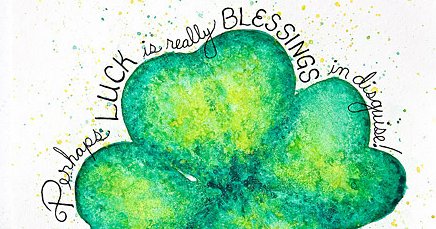
Lucky and Unlucky Days
You might want to plan moving, traveling, major purchases, court dates, and weddings around these dates, avoiding the unlucky days and utilizing the lucky ones. Interestingly, the 15th is both lucky and unlucky.
- These are the lucky days in December:
15, 19, 20, 22, 23 and 25. - These are the unlucky days in December:
6, 11, 14, 15 and 21.
Fatal Days
The seventh is a fatal day for human life,
The tenth is with a serpent’s venom rife.
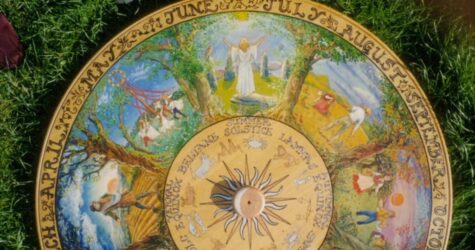 Holidays and Holy Days
Holidays and Holy Days
Many of the holidays begin on the eve of the night before and end on the eve of the day of. It’s also important to remember that the dates of archaic festivals and feast days may vary widely depending on the source.
December 1
- 1: The Festival of Poseidon – the Greek god of the sea. Poseidon is also the god of rebirth.
- 1 thru 24: Advent
December 3
- 3: The Sementivaem – the second festival of Tellus, the Roman earth goddess.
- 3 » Night of Hekate Suppers
December 4
- 4: Bona Dea – a Roman festival for women only
December 5
December 6
December 14
- 14: Halcyon Days Begin
- 14 » Day of Ekadashi (Hindu)
December 15
- 15: The second Festival of Consus – the Roman god of good council
- 15: Bill of Rights Day
December 17
- 17 » Friday the 17th
- 17: Beginning of Saturnalia – festival of Saturn, the Roman god of agriculture. The most popular Roman festival, for on this day the roles of master and slave were reverted.
December 18
- 18: Eponalia
December 19
- 19: The Festival of Ops – second festival of Ops, Roman goddess of harvest.
December 21
- 21: Poseidonia of Aegina – possibly lasting as long as 2 months
- 21: Death of Tammuz – Ancient Babylonian Yule Ritual
- 21: Divalia – Angeronalia, festival of Angerona, the Roman goddess of secrecy.
- 21: The Dōngzhì Festival
- 21: Yule (In the southern hemisphere this is Litha)
December 23
- 23: The Larentalia (Larentinalia) – festival of Acca Larentia the Roman goddess who gave the early Romans their land
December 24
- 24: Birth of the Unconquered Sun ~ Sol Invictus
- 24: Christmas Eve
December 25
- 25: Christmas
- 25: The Birthday of Mithra – the Persian god of light and wisdom.
- 25: Festival of the Invincible Sun God
- 25: Feast of Frau Halle – Germanic goddess
December 26
- 26: Boxing Day
- 26: Day of the Wren
December 27
- 27: Mother Night
December 28
- 28: Feast of the Holy Innocents
- 28: Childremass
- 28 » Dakini Day (Tibetan)
- 28: Dyzymas Day
December 29
- 29: Feast of Fools
- 29 thru Jan 3: Shōgatsu (Shinto)
December 30
- 30 » Day of Ekadashi (Hindu)
- 30: Bringing in the Boar
December 31
- 31: Watch Night
- 31: New Year’s Eve
- 31: Festival of Hogmanay
- 31: Stonehaven Fireball Ceremony
- 31: First Footing
 Saint Days
Saint Days
There is a surprising amount of magick associated with Saint days. This is a very short list of the Saint days in December, there are many many more. As time goes by I may end up listing them all, but for now, this is what I have.
- 6: Saint Nicholas Day
- 12: Feast day of Our Lady of Guadalupe
- 13: St. Lucy’s Day
- 26: St Stephen’s Day
- 27: St John’s Day
 Recipes For December
Recipes For December
- Anise Cookies For Yule – Yule, Christmas and the Winter Solstice
- Figgy Pudding – Yule, Christmas and the Winter Solstice
- Simple Wassail Recipe – Yule, Christmas and the Winter Solstice
- Swedish Yule Bread – Yule, Christmas and the Winter Solstice
- Traditional Wassail Recipe For Yule – Yule, Christmas and the Winter Solstice
- Yule Eggnog Bread – Yule, Christmas and the Winter Solstice
- Glutinous Rice Balls – Tang Yuan – Winter Solstice
- Lamb Dumplings – Dongzhi – Winter Solstice
Many more seasonal recipes, including recipes for new and full moon ceremonies, ancient Greek and Roman holidays, Asian festivals and etc can be found here: Seasonal Recipes.
 Notes:
Notes:
Any December lore, almanac, astrological, and celebration dates that have been shared after this post was published can be found by searching the December posts to see what’s new.
A lot of work went into this post. It was compiled from various sources by Shirley Twofeathers for The Pagan Calendar, you may repost and share without karmic repercussions, but only if you give me credit and a link back to this website. Blessed be.
The Elder Month is the last month in the cycle of the 13 Celtic months, and it indicates the renewal of energy and the continuous journey of the soul towards greater happiness and understanding. The Winter Solstice, the shortest day and longest night, occurs during the Elder Month, and offers the chance to focus on your heart’s desire.
- Dates: November 24 – December 22
- Celtic / Oghum Name: Ruis (pronounced roo-esh)
- Language of Flowers: Zealousness
- Qualities: Regeneration, Fertility, Healing, Otherworld, Balance, Wisdom, Knowledge, Calm, Winter, Witches, Wise Women, Cooling, Fairies, Crone Goddess
- Themes: Endings, Rebirth, Creativity, Renewal, Protection, Magick
The winter solstice has passed, and the Elder month is a time of endings. Although the Elder can be damaged easily, it recovers quickly and springs back to life, corresponding to the approaching New Year. The month of Elder is a good time for workings related to creativity and renewal. It is a time of beginnings and endings, births and deaths, and rejuvenation.
The Druids believed that it was during this period that their Sun or Solar Spirit was being held prisoner. It was also considered a time of trouble and indicative of the struggle for supremacy.
The Elder Moon is a time to bring a halt to habit-forming patterns that have been restricting your growth, so that you may heal and move on. Evaluate what you have learned during the past year and give yourself time to work out what you really want from life. Draw upon energy that concludes the annual cycle and release the energy you have invested in previous projects and endeavors, so that you may concentrate on conceiving your new dreams for the New Year.
Use the powers of the elder tree to bring a sense of completion to the old year and a feeling of renewal for the start of the next cycle. Try these simple rituals to bring a sense of completion to your Celtic lunar year.
- Review the last 13 Moon, writing down what you have learned from each. Acknowledging your lessons will help you move on.
- Areas of your life that feel unfulfilled indicate stuck energy. Hold a quartz crystal and direct love towards your current job, cramped flat, or credit card bill. New opportunities will appear as if my magic.
- Resolve difficult relationships by writing a letter to the soul of the person with whom you are in conflict. This helps to clear the way for change. Then burn the letter.
Elder the Seeker
The last in the Celtic tree astrology pantheon is the Elder tree sign. People from this sign love freedom and others may see them as wild and untamed. The slogan of their life is “Live fast”, always seeking thrills and adventures. They are often misunderstood and treated as outsiders, even though they are extroverts by nature. However, the Elder signs can be deeply thoughtful, often very considerate of others and love to lend a helping hand. This misjudged sign fits well with the Alder and Holly signs.
The Elder individual evolves gradually during his or her lifetime. In youth, such people are inclined to waste much time and energy on worthless ventures or projects. They are often fortunate individuals who frequently benefit at an early age from inheritances. However, this usually only encourages their extravagant tastes and indulgences.
With a basic restlessness and/or insatiable curiosity, Elder individuals are drawn into the study of profound subjects and are prone to travel great distances in order to further their knowledge. Elder individuals are self-sufficient, lively and outspoken. They dislike routine and refuse to be pressured by others. Highly energetic with a great deal of stamina, they thrive on change and crave constant mental and physical challenge.
In later life, the Elder individual commands respect and possesses a great deal of patience. Elder characters are often outspoken and prone to speak without first thinking, but they possess a constructive approach to life and are frequently drawn to careers in the military or journalism.
The true strength of Elders lie in the instinctive knowledge of when they are right and others are wrong, coupled with their inherent inclination toward self-discipline. The Elder individual is open in his or her relationships, but tends not to fall in love very deeply, seemingly able to remove their emotions from most situations.
While finding it difficult to tame their restless natures enough to take on parenthood, Elders do make wonderful uncles and aunts. It is important that Elder individuals learn to use change as a positive force in their lives in order to avoid becoming reckless and confused.
Elder Magick and Lore
Elder symbolizes judgement, transformation, death and regeneration, and fate. It is known as the Queen of all Herbs and rightly so; all parts of the Elder can be used medicinally. The lesson of the Elder is a difficult one but important and inevitable. It presents us with a looking glass into our own lives where we are faced to answer difficult questions about how we lived our lives and how we will be remembered; this was especially important to Celtic warriors.
Elder is also said to protect against demons and other negative entities. Use in magic connected to Faeries and other nature spirits.
Often planted close to the home, the Elder was thought to offer protection against evil influences and lightning…based on the fact that the tree itself never seemed to get struck and it was hoped such immunity would extend to the nearly dwellings. In ancient times, it was believed that negative forces would be attracted by someone who fell asleep beneath an Elder tree. While slumbering, it was thought such a person would suffer horrific nightmares and become delirious upon waking.
The elder tree’s ability to recover when damaged has made it a symbol of regeneration since ancient times and for this reason it was used in burial rites in British longbarrows (an ancient style of grave). Due to to its white flowers (life) and black berries (death), the tree is also sacred to the Mother Goddess who governs birth and death.
The wood of elder is believed to have protective properties because of the powerful Dryad spirit that lives within it. When planted near a home, the tree will ward off intruders. The healing powers of the elder are also thought to cure insomnia (by placing elderberries in a bad under a pillow) and ensure the health of unborn babies (when pregnant women kiss its bark).
To Release Negativity
Upon reaching the end of the Celtic calendar, the Elder Moon month is the perfect time to release negative energies before entering the New Year, feeling renewed.
Dig a hole in the ground and say, “Mother Earth, I ask you to transform my pain into healing.”
Place a photo of yourself and a drawing, or written account, of any negative incidents into the hole. Speak or shout your feelings into the hole.
When you feel ready place an elder twig into the hole to represent the end of the cycle. Fill in the hole and stamp the earth down three times saying, “I release the past, so mote it be.”
Sources:
The first of the 13 tree months of the Celtic calendar is the month of the Birch Moon. It begins just after Yuletide, and runs through most of January.
Starting just after the Winter Solstice – the shortest day of the year – the month of the Birch Moon marks the period of the year when the hours of daylight start to increase over the hours of darkness. Its associated color is flame red. From this comes the red candles that we burn at Yuletide. The birch is a popular Yule log, clearing the Old Year away to make way for the new.
- Dates: December 24 thru January 20
- Celtic Name: Beith, Beth
- Language of Flowers: Meekness
- Color: Red
- Themes: New Endeavors, Creativity, Fertility, Healing, Protection.
The Birch Moon is a time of rebirth and regeneration. As the Solstice passes, it is time to look towards the light once more. When a forested area burns, Birch is the first tree to grow back. The Celtic name for this month is Beth, pronounced beh.
Workings done in this month add momentum and a bit of extra “oomph” to new endeavors. The Birch is also associated with magick done for creativity and fertility, as well as healing and protection. Tie a red ribbon around the trunk of a Birch tree to ward off negative energy. Hang Birch twigs over a cradle to protect a newborn from psychic harm. Use Birch bark as magical parchment to keep writings safe.
Beth, the Birch month, is a time of regeneration and new projects. This is the perfect time to go back to the light once more as the Sun makes a comeback. The Birch tree is the first tree to grow back after a forest fire. This month is the best for spells related to creativity, healing, protection, and fertility.
Birch the Achiever
If you were born in the month of the birch, you probably have a fresh and unusual outlook on life. People born under this Celtic tree astrology sign tend to be highly driven and are always full of zeal and ambition. They always want more and try to reach new horizons and expand their knowledge.
Some of the characteristics attributed to the Birch sign are tolerance, toughness, and leadership. The Birch signs can brighten a room with their smile and quickly charm other people. This sign of the Celtic zodiac is compatible with the Vine and Willow signs.
Throughout history the birch tree was known for it’s adaptability, sustaining itself in even the harshest of conditions. It is the first tree to sprout leaves after the winter and the first to regrow after fire or other natural disaster. Some liken it to the pioneer spirit, courageously taking root in harsh and unknown lands. It is a symbol of renewal at the highest level and demonstrates a fierce and unfailing ability to not only survive, but also to prosper and multiply.
People born under this Druid zodiac sign may exhibit many of the characteristics of the tree such as strength, tenacity, resilience, stability and perseverance.
Birch Magick and Lore
Birch is one of our most beautiful native British trees and one of the most mystical! Birch is often seen as a ‘pioneer tree.’ It was the first tree to start to recolonize the land after the last Ice Age and is, even now, often the first to start to grow on cleared lands or wastelands…
And it provides nourishment for the plants and trees that come after to allow the natural ecosystem to regrow. Because of this, birch is often associated with renewal and new beginnings.
In the Tartar culture, the birch tree stands at the centre of the world. The Siberian Buryat people name birch ‘the guardian of the door’ and believe that the birch can provide access to the nine great celestial realms.
The Siberian Yakut culture associate the birch with ‘Ai Toyou’ the ‘bringer of light’ who lives in a birch tree with its branches filled with nests of children.
The association of birch with light is a powerful one – the beautiful silver-white bark reflects light and appears particularly striking and ethereal by moonlight, especially on those dark winter nights when the trees stand bare of leaves.
Birch is associated with the Celtic god of light, Lugh. And legend tells that birch – ‘beith’ – was the first letter of the Celtic tree alphabet – the ogham – ever written. The letter ‘beith’ was carved seven times onto a piece of birch by the god Ogma so that he could warn the god Lugh that his wife had been taken by fairies. It also served as a protective talisman for Lugh as he sought for his wife.
In the Celtic world, birch trees are also associated with the Northern Lights, the Aurora Borealis – you can imagine the ethereal beauty of the scene with these dancing lights reflected in the silver birch bark – and through this association, with the Celtic goddess Arianrhod who has her throne in the ‘corona borealis’, ‘the crown of the north wind’. Celtic women are thought to have traditionally used birch to ask for Arianrhod’s assistance in childbirth (a time of new beginnings).
Simple Cold Moon ritual
Light a white candle beside a small bowl of natural spring water. Stand over the water and pray for the strength to let go of your vice. Write down your negative behavior nine times on a piece of paper. Fold up the paper, place it inside a freezer bag, and pour in some of the prayer water. Place the bag inside your icebox to ‘freeze’ your bad habits – putting them behind you forever.
Sources:
According to astrological and lunar lore, there are best days for doing a variety of tasks. The best days listed here are based on both the phase of the moon and its position in the zodiac. Many people believe that if you do the tasks on the dates listed, you will get the best results possible.
December 1:
- Castrate Farm Animals
- Cut Firewood
- Dig Holes
- Kill Plant Pests
- Mow Grass (to increase growth)
- Paint
- Potty Train a Child
- Wean a Baby or an Animal
December 2:
- Castrate Farm Animals
- Cut Firewood
- Dig Holes
- Kill Plant Pests
- Mow Grass (to increase growth)
- Paint
- Potty Train a Child
- Wean a Baby or an Animal
December 3:
- Castrate Farm Animals
- Cut Firewood
- Cut Hair (to increase growth)
- Dig Holes
- Get Married
- Mow Grass (to increase growth)
- Plant Above Ground Crops
- Potty Train a Child
- Start Diet (to gain weight)
- Wax Floors
- Wean a Baby or an Animal
December 4:
- Castrate Farm Animals
- Cut Firewood
- Cut Hair (to increase growth)
- Dig Holes
- Get Married
- Mow Grass (to increase growth)
- Plant Above Ground Crops
- Potty Train a Child
- Start Diet (to gain weight)
- Wax Floors
- Wean a Baby or an Animal
December 5:
- Bake
- Cut Firewood
- Dig Holes
- Kill Plant Pests
- Mow Grass (to increase growth)
December 6:
- Bake
- Cut Firewood
- Dig Holes
- Kill Plant Pests
- Mow Grass (to increase growth)
December 7:
- Bake
- Cut Firewood
- Dig Holes
- Kill Plant Pests
- Mow Grass (to increase growth)
December 8:
- Advertise Something for Sale
- Cut Firewood
- Cut Hair (to increase growth)
- Dig Holes
- Get Married
- Mow Grass (to increase growth)
- Paint
- Plant Above Ground Crops
- Wax Floors
December 9:
- Advertise Something for Sale
- Cut Firewood
- Cut Hair (to increase growth)
- Dig Holes
- Get Married
- Mow Grass (to increase growth)
- Paint
- Plant Above Ground Crops
- Wax Floors
December 10:
- Cut Firewood
- Dig Holes
- Kill Plant Pests
- Mow Grass (to increase growth)
- Set Eggs
- Travel (for pleasure)
December 11:
- Cut Firewood
- Dig Holes
- Kill Plant Pests
- Mow Grass (to increase growth)
- Set Eggs
- Travel (for pleasure)
December 12:
- Brew
- Can Fruits and Vegetables
- Hunting
- Mow Grass (to slow growth)
- Plant Flowers
- Plant Root Crops
- Plant Seed Beds
- Slaughter
- Transplant (seedlings and plants)
December 13:
- Brew
- Can Fruits and Vegetables
- Hunting
- Mow Grass (to slow growth)
- Plant Flowers
- Plant Seed Beds
- Slaughter
- Transplant (seedlings and plants)
December 14:
- Ask For a Loan
- Cut Hair (to slow growth)
- Demolition
- Dig Post Holes
- Dry Fruits and Vegetables
- Kill Plant Pests
- Mow Grass (to slow growth)
- Paint
- Pick Apples and Pears
- Quit Smoking
- Start Diet (to lose weight)
- Wash Wooden Floors
December 15:
- Ask For a Loan
- Cut Hair (to slow growth)
- Demolition
- Dig Post Holes
- Dry Fruits and Vegetables
- Kill Plant Pests
- Mow Grass (to slow growth)
- Paint
- Pick Apples and Pears
- Plant Root Crops
- Quit Smoking
- Start Diet (to lose weight)
- Wash Wooden Floors
December 16:
- Ask For a Loan
- Cut Hair (to slow growth)
- Demolition
- Dig Post Holes
- Dry Fruits and Vegetables
- Kill Plant Pests
- Mow Grass (to slow growth)
- Paint
- Pick Apples and Pears
- Plant Root Crops
- Quit Smoking
- Start Diet (to lose weight)
- Wash Wooden Floors
December 17:
- Kill Plant Pests
- Mow Grass (to slow growth)
- Quit Smoking
- Start Diet (to lose weight)
December 18:
- Harvest
- Kill Plant Pests
- Mow Grass (to slow growth)
- Quit Smoking
- Start Diet (to lose weight)
December 19:
- Cut Hair (to slow growth)
- Get Married
- Mow Grass (to slow growth)
- Plant Flowers
December 20:
- Cut Hair (to slow growth)
- Get Married
- Mow Grass (to slow growth)
December 21:
- Can Fruits and Vegetables
- Make Jams and Jellies
- Mow Grass (to slow growth)
- Plant Root Crops
- Plant Seed Beds
- Prune Trees
- Transplant (seedlings and plants)
December 22:
- Can Fruits and Vegetables
- Make Jams and Jellies
- Mow Grass (to slow growth)
- Plant Flowers
- Plant Root Crops
- Plant Seed Beds
- Prune Trees
- Transplant (seedlings and plants)
December 23:
- Advertise Something for Sale
- Castrate Farm Animals
- Cut Hair (to slow growth)
- Demolition
- Harvest
- Kill Plant Pests
- Mow Grass (to slow growth)
- Pick Apples and Pears
- Plant Root Crops
- Potty Train a Child
- Quit Smoking
- Start Diet (to lose weight)
- Wash Windows
- Wash Wooden Floors
- Wean a Baby or an Animal
December 24:
- Advertise Something for Sale
- Castrate Farm Animals
- Cut Hair (to slow growth)
- Demolition
- Harvest
- Kill Plant Pests
- Mow Grass (to slow growth)
- Pick Apples and Pears
- Plant Root Crops
- Potty Train a Child
- Quit Smoking
- Start Diet (to lose weight)
- Wash Windows
- Wash Wooden Floors
- Wean a Baby or an Animal
December 25:
- Castrate Farm Animals
- Mow Grass (to slow growth)
- Plant Root Crops
- Potty Train a Child
- Prune Trees
- Wean a Baby or an Animal
December 26:
- Bake
- Castrate Farm Animals
- Cut Firewood
- Cut Hair (to increase growth)
- Dig Holes
- Mow Grass (to increase growth)
- Plant Above Ground Crops
- Potty Train a Child
- Wax Floors
- Wean a Baby or an Animal
December 27:
- Bake
- Castrate Farm Animals
- Cut Firewood
- Cut Hair (to increase growth)
- Dig Holes
- Mow Grass (to increase growth)
- Plant Above Ground Crops
- Potty Train a Child
- Wax Floors
- Wean a Baby or an Animal
December 28:
- Castrate Farm Animals
- Cut Firewood
- Dig Holes
- Kill Plant Pests
- Mow Grass (to increase growth)
- Paint
- Potty Train a Child
- Wean a Baby or an Animal
December 29:
- Castrate Farm Animals
- Cut Firewood
- Dig Holes
- Kill Plant Pests
- Mow Grass (to increase growth)
- Paint
- Potty Train a Child
- Wean a Baby or an Animal
December 30:
- Castrate Farm Animals
- Cut Firewood
- Cut Hair (to increase growth)
- Dig Holes
- Get Married
- Mow Grass (to increase growth)
- Plant Above Ground Crops
- Potty Train a Child
- Start Diet (to gain weight)
- Wax Floors
- Wean a Baby or an Animal
December 31:
- Castrate Farm Animals
- Cut Firewood
- Cut Hair (to increase growth)
- Dig Holes
- Get Married
- Mow Grass (to increase growth)
- Plant Above Ground Crops
- Potty Train a Child
- Start Diet (to gain weight)
- Wax Floors
- Wean a Baby or an Animal
Source: The Farmer’s Almanac
Dakini day, celebrated on the 25th day of each lunar month in Vajrayana Buddhist traditions, celebrates the feminine energy of wisdom. Devoted Buddhists will celebrate with a Tsok (Tsog), a feast including food, singing, a group (or single) sadhana full of sound and celebration. Most Tibetan Buddhist temples and meditation centers try to arrange a monthly Tsog on this day each month, with celebrants bringing food as offerings. It is always a happy day, that invites blessings not only for the attendees, but for all sentient beings.
This is one of the special days during a month, when Vajrayana practitioners perform a ritual of offering and purification of their commitments. It is believed that on this particular day, all the Dakinis gather in special sacred places and their energy is potently vivid and present at that moment.
When we perform practice on those auspicious days, we can connect with this potent energy and thus gain a lot of merit. It allows us to develop our practice and capacities, as well as purify our defilements and mistakes that we have accumulated with time. In this way, Dakini Day becomes very important for Vajrayana practitioners.
What is a Dakini?
The Dakini is a female being of generally volatile temperament, who acts as a muse for spiritual practice. Dakinis can be likened to elves, angels, or other such supernatural beings, and are symbolically representative of testing one’s awareness and adherence to Buddhist tantric sadhana.
Dakinis are portrayed as elusive, playful and often fierce and naked to symbolically convey how elusive true Wisdom encompassing “Emptiness” can be.
Without contradiction to their role as exemplars of Emptiness, Dakinis can also represent fierce activities, such as protection — the ferocious protective love of a mother.
Khandro Rinpoche defines the authentic Dakini principle as “a very sharp, brilliant wisdom mind that is uncompromising, honest, with a little bit of wrath.”
Dakinis appear in many forms. “The Dakinis are the most important elements of the enlightened feminine in Tibetan Buddhism,” says American teacher Tsultrim Allione. “They are the luminous, subtle, spiritual energy, the key, the gatekeeper, the guardian of the unconditioned state. If we are not willing to invite the Dakini into our life, then we cannot enter these subtle states of mind. Sometimes the Dakinis appear as messengers, sometimes as guides, and sometimes as protectors.”
Dakini are timeless, inorganic, immortal, non-human beings who have co-existed since the very beginning with the Spiritual Energy. In some New Age belief systems, they are angelic. This New Age paradigm differs from that of the Judeo-Christian by not insisting on angels being bona fide servants of God.
Moreover, an angel is the Western equivalent of a Dakini. The behavior of Dakini has always been revelatory and mysterious; they respond to the state of spiritual energy within individuals. Love is their usual domain – one explanation for Dakini or angels supposedly living in the sky or heaven. Manifestations of Dakini in human form occur because they supposedly can assume any form. Most often they appear as a human female. By convention, a male of this type is called a ‘Daka’.
In Buddhism, typically, the male Buddhas represent compassionate means, while the female Buddhas represent Wisdom. The symbols of bell and vajra (Ghanta and Dorje) represent female wisdom — the bell, which makes the sound of “Emptiness” — and the Vajra, representing compassionate means.
Dakini’s have always been a part of Buddhism, starting with the Jataka’s (stories of Buddha’s former lives) in which “divine beings are described as travelling through the air. In Sanskrit, such a being is called a Dakini, a term generally translated as “space-goer,” “celestial woman,” or “cloud fairy.”
Dakinis are typically thought of as the emanation of the “Enlightened Mind” understanding Emptiness. Another concept usually tied to Dakini practice is “bliss” — the state of blissful awareness of emptiness.
It is a wonderful experience to have a moment that realizes emptiness, a feeling of joy-bliss rather than “nothingness.” This is why Dakinis are often portrayed as active, dancing, joyful or fierce, naked and unencumbered.
Five Dakini Healing Mantra
The meaning of Dakini is the female enlightened energy and the awakened state of consciousness. Therefore, chanting this mantra increases and enhances all enlightened feminine energy.
Bam Ha Ri Ni Sa
The 5 Dakini also represents each of the 5 Elements:
- BAM ~ Buddha Dakini ~ (blue) ~ Mind energy, pacifies Ignorance
- HA ~ Vajra Dakini ~ (white) ~ Body energy, pacifies Anger
- RI ~ Ratna Dakini ~ (yellow) ~ Knowledge/Qualities/Healing, pacifies Ego/Pride
- NI ~ Padma Dakini ~ (red) ~ Speech energy, pacifies Desire
- SA ~ Karma Dakini ~ (green) ~ Action/Removes Obstacles, pacifies Jealousy
This mantra is helpful for all female related health issues, transforms negative emotions, unblocks channels, and balance 5 elements. When chanting this mantra on Dakini Day, the power magnifies ten-fold!
After chanting, blow into a glass of water, which infuses the healing vibration into the water, drink, and continue to enjoy its healing properties.
Sources:
“Welcome everything! Welcome all alike what has been, and what never was, and what we hope may be, to your shelter underneath the holly, to your places around the Christmas fire, where what is sits.”
~Charles Dickens
The wassail—a centuries old tradition from Great Britain—is a joy-filled party celebrating the Winter Solstice, Christmastime and happy tidings. Indeed, many of the traditions of this likeable event are the originators of well-known seasonal classics (like caroling, for one).
The word wassail itself comes from the old Norse “ves heill,” which literally means “be healthy.” It is a toast of goodwill and is at the heart of what wassailing is all about.
These days a wassail is a party, but, in centuries past wassailing mainly involved people singing carols from door-to-door, such as “Here We Come a Wassailing” or “We Wish You a Merry Christmas.” Sound familiar? The carolers would carry a bowl of wassail, which was a hot mulled wine or some kind of warm, apple-based beverage. Often people floated a piece of toasted bread on top of the steaming wassail, which was the origin of our modern-day expression “I would like to propose a toast.”
When carolers entered a home they would sing, share the wassail and receive eats and drinks themselves (such as plum pudding or shepherd’s pie), at which time toasts for a merry Christmas and happy tidings for a new year would be exchanged by all.
One legend about how Wassailing was created, says that a beautiful Saxon maiden named Rowena presented Prince Vortigen with a bowl of wine while toasting him with the words ‘waes hael‘. Over the centuries, a great deal of ceremony developed around the custom of drinking wassail. The bowl was carried into a room with a great fanfare, a traditional carol about the drink was sung, and finally, the steaming hot beverage was served.
Today, wassails are still held in homes or as public celebrations in many countries throughout the world, such as Great Britain, Canada and the U.S. The celebrations can be as simple as gathering some friends for hot cider to more elaborate celebrations involving the production of short plays (called mummer plays) or caroling through apple orchards.
To host your own wassail:
- Invite friends and family to share the occasion.
- Dress up the house for a festive holiday occasion.
- Serve a warm beverage, such as spiced apple cider, mulled wine or the like, from a bowl. This is a must! Otherwise, it’s not really a wassail.
- Serve food that’s warm and hearty, like beef pot pie or warm potato wedges with bacon, cheese and sour cream toppings. Christmas pudding or any kind of spice cake or pound cake should do nicely for dessert.
- Play festive Christmas music in the background. (Or, better yet, sing along with carols if so inclined.)
- Partake in games that involve teams of players, like charades, Cranium, Pictionary or Taboo.
The object is simply to have a good time and share the joy of the season!
One of the most popular Wassailing Carols:
A Wassail Bowl
Here we come a-wassailing
Among the leaves so green,
Here we come a-wassailing,
So fair to be seen:
Love and joy come to you,
And to you your wassail too,
And God bless you and send you,
A happy New Year,
And God send you,
A happy new year.
Here is a simple wassail ceremony.
- Heat a large container of ale or beer – about 3 or 4 pints.
- Add 1/2 cup sugar and 1/4 cup mixed spices (cinnamon sticks and whole cloves are also excellent)
- Cut up 2 or 3 small sweet apples and add those.
- Add 1 1/4 cup of pineapple juice and the same of orange.
- Squeeze 2 lemons into the brew.
Place over a slow flame; then, before it begins to boil, take off the heat and whip up some cream. Let this float on top of the brew like foam. Put into a suitably large bowl (the more ornate the better).
Toast several slices of bread, if you have fruit cake you can use pieces of that instead.
Now, with a few friends, go out to the tree or trees (see note below).
Dip pieces of toasted bread into the brew and place in the branches of the tree. Hang pieces of bread and cake from the higher twigs to encourage robins (guardian spirits of the trees). Bend the lower branches down and dip their ends in the brew.
Wet the roots liberally with the brew. Pass the rest around and when everyone is thoroughly warmed up, sing a wassailing song. Lift your glasses to the tree and shout “Huzzah!” three times as loudly as you can.
Note:
These don’t have to be apple trees, since any tree will benefit from a well-intentioned blessing, but it is traditional to wassail fruit-bearing trees. You can wassail the trees in your yard, near your home, or trees in some previously selected area.
The Sun will “die” at midnight on December 21, but don’t panic, it will “rebirth” on midnight December 24. This occurs at the beginning of Winter every year for the past 4.6 billion years. It is called the Winter Solstice, “sun stood still”, and is considered the shortest day in the year in terms of hours of sunlight.
It is a three-day period when the hours of daylight are at its shortest and the hours of night (darkness) are at its longest. Noticeably, the sun progressively sets earlier each evening after June 22 (The Summer Solstice – longest hours of sunlight) and night fall comes the earliest on December 21. Hence daylight savings time put our clock one hour back to make up for the shorter hours of day light.
Needless to say, the Sun is vital to our life here on earth and is one of the most important star in our world. It is the nearest star to Earth and is believed to be formed 4.6 billion years ago. It is the most important source of energy for life on Earth and its diameter is about 109 times that of Earth, with mass about 330,000 times that of Earth. The sun accounts for about 99.86% of the total mass of the Solar System and is so large that about 1,300,000 planet Earths can fit inside of it.
Awesome.
WOW.
Worthy of Worshiping?
Sun Worship
Well, our ancestors did just that more than 9000 years ago and it is still being done today. The ancients selected December 21, the Winter Solstice as the ideal time to invoke the sun. Maybe if you were living in the north pole and had long, dark harsh winters to deal with you might want to invoke the sun too.
In the solar myth, the death of the “old sun” occurs as the length of daylight decreases and becomes its lowest at the Winter Solstice which begins on the midnight of December 21 (early morning December 22) and ends on Midnight December 24 (early morning December 25). The sun stop moving south on December 22, it is then at its lowest point in the Northern Hemisphere, residing in the vicinity of the Southern Cross. It stays at this lowest point for three days (December 22, 23, 24 appearing to not moving south or north and was considered “dead”).
It “returns to life” at midnight on December 24/ early morning December 25, when it begins its northern journey again and the hours of sunlight start to lengthen. Therefore, the ancients said that the SUN was born on December 25. As a result, festivals and feasts were done to honor Sol or Mithra.
Interestingly, on December 24, Sirius (star in the east and brightest star in the night sky) aligns with the three brightest Orion belt stars called the Three Kings, (Alnitak, Alnilam and Mintaka) and on December 25, these all point to the location where the sun will rise on earth that day. In essence, the three kings follow the star in the east to find the sunrise (birth of the sun).
Solar deities and Sun worship can be found throughout most of recorded history in various forms, including:
- Ra ~ Egypt,
- Mithra ~ Persia,
- Apollo ~ Rome
- Surya ~ India
- Amaterasu ~ Japan
- Sol ~ Germanic
- Tonatiuh ~ Aztec
- Jesus ~ Christianity
Birthday of the SUN or the SON?
As a Baptist, I grew up with the belief that December 25 is the birthdate of Jesus Christ and as such we worship and acknowledge it as Christmas. Indeed, Christmas is big— very big. The entire Island of Jamaica comes to a virtual standstill. Schools and colleges are closed; businesses shut down to give their employees time off; many families plan trips and get-togethers; Church attendance increase; and gifts are given by even those who were scrooge all year long. Maybe you recall, the Christmas Carol that even erroneously say “ Long time ago in Bethlehem, so the Holy Bible said, Mary’s boy child Jesus Christ, was born on Christmas Day”
However, recall all these activities were already being done in Rome, Babylon, Persia, Greece, and Egypt to acknowledge and worship the birth day of Sol Invicta (the Unconquered Sun) up to 4000 years before Jesus Christ was born. It then begs the question, whose birthday are we celebrating on December 25? Does Jesus the SON share the birthday with the SUN?
How did the birth of the Sun get changed?
According to scriptures, Jesus Christ was whipped, spat upon, publicly dishonored then killed by the Church (Caiaphas the high priest) and the State (Pilate the Roman governor). After Jesus’s death, his followers had to go “underground” as they too were meeting the same or worse fate than Christ. These “Followers of Christ” (not Christians as Christianity wasn’t start as yet) were stripped and flogged with whips, stoned to death, and persecuted.
Yet, despite the persecution, the “Followers of Jesus” went underground and their church started to flourish and soon became a major concern to the Roman government. They were blamed for spreading “mischief” that Jesus Christ was king and lord, and was crucified to save our souls. Followers of Christ were also accused of destabilizing the economy and threatening civil war.
To stop the possibility of civil war and at the same time keep the existing pagan occult worshipers, Constantine, in AD 326 at the Council of Nicaea, “married” Christ like sentiments (name and life story) with that of Rome’s mysticism and called it Christianity. This new “Christianity” became the official religion of Rome and the SUN was replaced by the SON with Isis and Osiris became Mary and Jesus. December 25 was then decreed as Jesus birthday with the Spring Equinox full moon in March/April designated as his death day.
In short, today’s Christianity is an unholy marriage of Roman Idolatry and Christ sentiments designed by Constantine to maintain religious and political if not economical order and harmony in the empire.
Sol Invictus (Unconquered Sun) is a very important star in our solar system without a doubt. As the main source of energy, we can understand the need to recognize it and maybe even glorify its daily presence in our lives. Many people deliberately and some unwittingly worship and glorify the SUN between December 21 – 25 to show appreciation.
If you are interested, a Ritual to Bring The Sun can be found in the Book of Shadows, and a number of invocations, prayers, and poetry specifically dedicated to the Sun can be found at Widdershins.
Honoring The Sun Every Day
One really great way to honor the Sun (and yourself) is with a series of body positions called Sun Salutations. An excellent time to begin this ritual is on the morning of the Winter Solstice just as the sun is rising, (facing east). If a sunrise Sun Salutation isn’t possible, but you want to include this in your morning routine, pick a time before breakfast, and that will be fine.
The Sun Salutation, (Surya Namaskar), is a series of 12 yoga postures performed in a single, graceful flow. Each movement is coordinated with the breath. Inhale as you extend or stretch, and exhale as you fold or contract. The Sun Salutation builds strength and increases flexibility. Different styles of yoga perform the Sun Salutation with their own variations. However, the flow presented below covers core steps used in most styles.
For the series below, a single round consists of two complete sequences: one for the right side of the body and the other for the left.
Sun Salutations
Even on days when you think you have no time for yoga, try and do at least one or two rounds of the Sun Salutation. You’ll feel the difference.
 1. Mountain:
1. Mountain:
Begin by standing in Mountain pose, feet about hip width apart, hands either by your sides or in prayer position. Take several deep breaths.
 2. Hands up:
2. Hands up:
On your next inhale, in one sweeping movement, raise your arms up overhead and gently arch back as far as feels comfortable and safe.
 3. Head to knees:
3. Head to knees:
As you exhale, bend forward, bending the knees if necessary, and bring your hands to rest beside your feet.
 4. Lunge:
4. Lunge:
Inhale and step the right leg back.
 5. Plank
5. Plank
Exhale and step the left leg back into plank position. Hold the position and inhale.
 6. Stick
6. Stick
Exhale and lower yourself as if coming down from a pushup. Only your hands and feet should touch the floor.
 7. Upward Dog
7. Upward Dog
Inhale and stretch forward and up, bending at the waist. Use your arms to lift your torso, but only bend back as far as feels comfortable and safe. Lift your legs up so that only the tops of your feet and your hands touch the floor. It’s okay to keep your arms bent at the elbow.
 8. Downward dog
8. Downward dog
Exhale, lift from the hips and push back and up.
 9. Lunge
9. Lunge
Inhale and step the right foot forward.
 10. Head to knees
10. Head to knees
Exhale, bring the left foot forward and step into head-to-knee position.
 11. Hands up
11. Hands up
Inhale and rise slowly while keeping arms extended .
 12. Mountain
12. Mountain
Exhale, and in a slow, sweeping motion, lower your arms to the sides. End by bringing your hands up into prayer position. Repeat the sequence, stepping with the left leg.
Put it all together, and it looks like this:
If the stick figures are not quite “doing” it for you, here’s a video:
Source: Notclif
- One practice consists of lighting and burning a Yule Log.
If you choose to burn one, select a proper log of oak or pine. Carve (with your Bolline) or chalk upon it a figure of the Sun (a rayed disc) or the Horned God (a horned circle). Set it alight in the fireplace at dusk, on Yule. This is a graphic representation of the rebirth of the God within the sacred fire of the Mother Goddess.
As the log burns, visualize the Sun shining within it and think of the coming warmer days. Traditionally, a portion of the Yule Log is saved to be used in lighting next year’s log. This piece is kept throughout the year to protect the home.
- The second type of Yule Log is not burned up, but rather holds three candles for burning.
Find a suitable log of oak or pine and flatten one side of it so that it will lay flat. Drill three holes in the side that is up, the correct size for holding three taper candles. The candles should be red, green and white (to represent the season), or green, gold and black (to represent the Sun God), or white, red and black (to represent the Great Goddess).
You can further decorate your Yule Log however you choose to – using holly, mistletoe, red ribbons and bows, or whatever you prefer.
Source: Citadel of the Dragons
Winter Solstice has been celebrated in cultures the world over for thousands of years. This start of the solar year is a celebration of Light and the rebirth of the Sun. In old Europe, it was known as Yule, from the Norse, Jul, meaning wheel.
Today, many people in Western-based cultures refer to this holiday as “Christmas.” Yet a look into its origins of Christmas reveals its Pagan roots.
Emperor Aurelian established December 25 as the birthday of the “Invincible Sun” in the third century as part of the Roman Winter Solstice celebrations. Shortly thereafter, in 273, the Christian church selected this day to represent the birthday of Jesus, and by 336, this Roman solar feast day was Christianized. January 6, celebrated as Epiphany in Christendom and linked with the visit of the Magi, was originally an Egyptian date for the Winter Solstice.
Most of the customs, lore, symbols, and rituals associated with “Christmas” actually are linked to Winter Solstice celebrations of ancient Pagan cultures. While Christian mythology is interwoven with contemporary observances of this holiday time, its Pagan nature is still strong and apparent.
Pagans today can readily re-Paganize Christmastime and the secular New Year by giving a Pagan spiritual focus to existing holiday customs and by creating new traditions that draw on ancient ways. Here are some ways to do this: Celebrate Yule with a series of rituals, feasts, and other activities.
In most ancient cultures, the celebration lasted more than a day. The ancient Roman Saturnalia festival sometimes went on for a week. Have Winter Solstice Eve and Day be the central focus for your household, and conceptualize other holiday festivities, including New Year’s office parties and Christmas visits with Christian relatives, as part of your Solstice celebration. By adopting this perspective, Pagan parents can help their children develop an understanding of the multicultural and interfaith aspects of this holiday time and view “Christmas” as just another form of Solstice.
Have gift exchanges and feasts over the course of several days and nights as was done of old. Party hearty on New Year’s Eve not just to welcome in the new calendar year, but also to welcome the new solar year.
Adorn the home with sacred herbs and colors. Decorate your home in Druidic holiday colors red, green, and white. Place holly, ivy, evergreen boughs, and pine cones around your home, especially in areas where socializing takes place.
Hang a sprig of mistletoe above a major threshold and leave it there until next Yule as a charm for good luck throughout the year. Have family/household members join together to make or purchase an evergreen wreath. Include holiday herbs in it and then place it on your front door to symbolize the continuity of life and the wheel of the year. If you choose to have a living or a harvested evergreen tree as part of your holiday decorations, call it a Solstice tree and decorate it with Pagan symbols.
Convey love to family, friends, and associates. At the heart of Saturnalia was the custom of family and friends feasting together and exchanging presents. Continue this custom by visiting, entertaining, giving gifts, and sending greetings by mail and/or phone. Consider those who are and/or have been important in your life and share appreciation.
Reclaim Santa Claus as a Pagan Godform. Today’s Santa is a folk figure with multicultural roots. He embodies characteristics of:
- Saturn (Roman agricultural god)
- Cronos (Greek god, also known as Father Time)
- Holly King (Celtic god of the dying year)
- Father Ice/Grandfather Frost (Russian winter god)
- Thor (Norse sky god who rides the sky in a chariot drawn by goats)
- Odin/Wotan (Scandinavian/Teutonic All-Father who rides the sky on an eight-legged horse)
- Frey (Norse fertility god)
- Tomte (a Norse Land Spirit known for giving gifts to children at this time of year)
Santa’s reindeer can be viewed as forms of Herne, the Celtic Horned God. Decorate your home with Santa images that reflect His Pagan heritage.
Honor the Goddess as Great Mother. Place Pagan Mother Goddess images around your home. You may also want to include one with a Sun child, such as Isis with Horus. Pagan Goddess forms traditionally linked with this time of year include:
- Tonantzin (Native Mexican corn mother)
- Holda (Teutonic earth goddess of good fortune)
- Bona Dea (Roman women’s goddess of abundance and prophecy)
- Ops (Roman goddess of plenty)
- Au Set/Isis (Egyptian/multicultural All Goddess whose worship continued in Christian times under the name Mary)
- Lucina/St. Lucy (Roman/Swedish goddess/saint of light)
- Befana (Italian Witch who gives gifts to children at this season)
Honor the new solar year with light. Do a Solstice Eve ritual in which you meditate in darkness and then welcome the birth of the sun by lighting candles and singing chants and Pagan carols.
If you have a indoor fireplace or an outdoor fire circle, burn an oak log as a Yule log and save a bit to start next year’s fire. Decorate the inside and/or outside of your home with electric colored lights. Because of the popularity of five pointed stars as holiday symbols, this is a good time to display a pentagram of blue or white lights.
Contribute to the manifestation of more wellness on Planet Earth. Donate food and clothing to poor in your area. Volunteer time at a social service agency. Put up bird feeders and keep them filled throughout the winter to supplement the diets of wild birds. Donate funds and items to non-profit groups, such as Pagan/Wiccan churches and environmental organizations. Meditate for world peace. Work magic for a healthier planet. Make a pledge to do some form of good works in the new solar year.
by Selena Fox
Burning the Devil or La Quema del Diablo is a tradition held every December 7, at 6:00 in the evening sharp, families build bonfires outside their homes and burn effigy of Satan. It is a tradition that many Guatemalans take part as a way to cleanse their home from devils that lurk in their home, creeping behind the furniture or hiding under the bed.
La quema del diablo can be traced to colonial time, a tradition that started since the 18th century. Held on the eve of the Feast of the Immaculate Conception and as a prelude to holiday season, those who could afford it adorns the fronts of their houses with lanterns, but for those who have lesser means builds a bonfires from their trash to celebrate the occasion.
A symbolical tradition with a belief that the fire burns the devil serves as purifying element, as the Virgin Mary was the blessed one to conceive baby Jesus must be free from any form of evil, therefore the event serves as “burning the devil” to clear the way for Mary’s feast.
Though the celebration may sound fun, it is controversial especially for the environmentalist groups. Back in the days, mostly paper were burned for the “cleansing ritual”, but now, piles of rubbish are mostly made of plastic and rubber that causes air pollution.
Over time the tradition evolved, from burning piles of garbage and pieces of furniture to being replaced by the effigy of Satan in a form of piñatas.
The tradition has special significance in Guatemala City because of its anticipation of Feast of the Immaculate Conception, the patron saint of the city. Along the street of Zona 1, the historic city center, many vendors pile the street selling stuffs associated with La Quema del Diablo, from firecrackers to simple and intricate devil piñatas. In different parts of the city, people celebrate and burn their own devil piñatas.
The tradition continues, as the idea is to burn all the bad from the previous year and to start anew from the ashes. It is widely observed throughout the country, The Devil is burned at the stroke of six. In Antigua, the former capital of the country, a devil three stories tall is constructed and burned in the city square.
A variation of this tradition is held in San Antonio Palopo. In this very unique celebration, they carry a statue of Maximón around town with a noose around his neck, they locals then hang Maximón by his neck in front of Catholic church, douse him with gasoline, and set him on fire. This is the local way of showing respect to the Christian god.
Setting people on fire has been a way of ridding the town of evil doers for many centuries. As soon as the Spaniards settled in Guatemala they brought with them the Christian religion. The Christian religion frowned on bloodshed. So instead they burned evil doers alive to kill them. This way they did not shed blood and therefor committed no sin.
Most of the inhabitants still pray to both the Christian and Mayan gods and deities such as Maximón or ancestors. They often ask for healing, wealth, help with love and sexual fertility.
The locals say they pray to both just in case one god does not grant their wishes the other might. This happens with both evangelical and Catholic believers. ( Not all, but the majority) This is kept secret for fear of discrimination from others.
While the many of the locals pray to both god and deities they publicly denounce Maximón shortly before Christmas by dragging him around the village then hang him with a noose and set him on fire.
The political version of this festival:
Guatemalans burn traditional devil puppets to start their Christmas celebrations. The ceremonial burning of devils started in the 16th century and is meant to chase away bad spirits. And in 2016, US president-elect Donald Trump was a big hit. But not in a good way.
Revelers in Guatemala set ablaze cardboard piñata of Trump wearing devil horns. In fact, piñata makers said Trump is far and away the best-seller. Trump’s hardline stance on immigration during his election campaign, including a promise to build a wall along the US-Mexico border, has drawn anger from Latin Americans in the US and around the world.
So this is a way to vent out the anger? It can be. Guatemalans believe the practice of torching the devil helps banish bad spirits from their homes and neighborhoods.
Sources:
